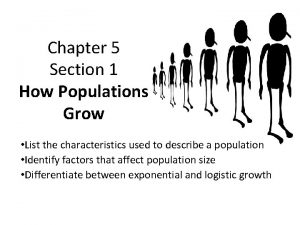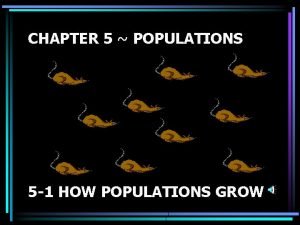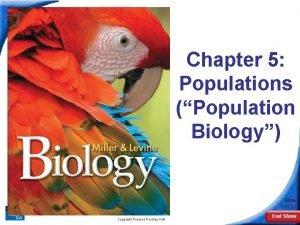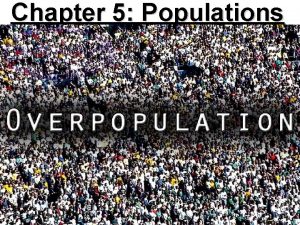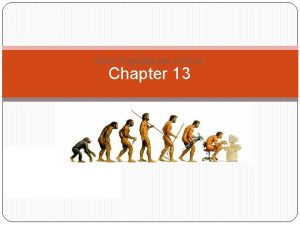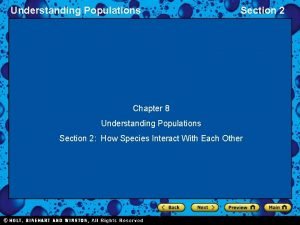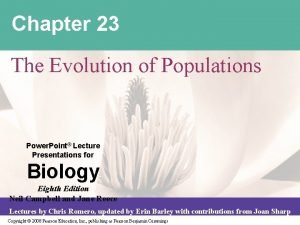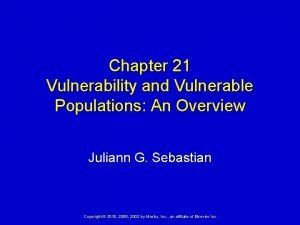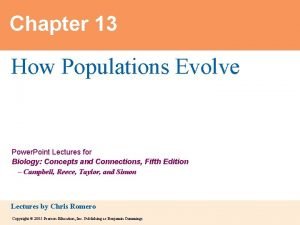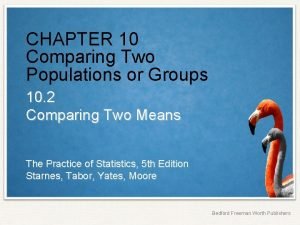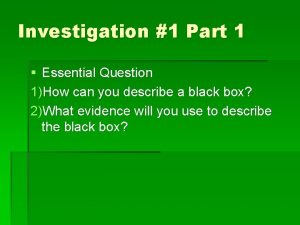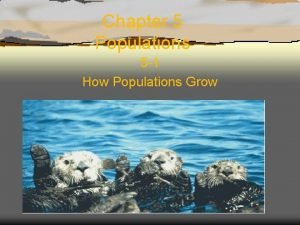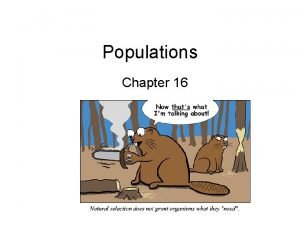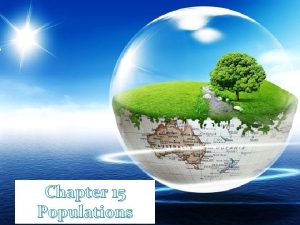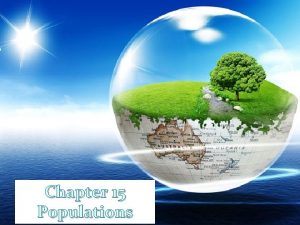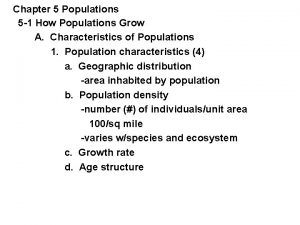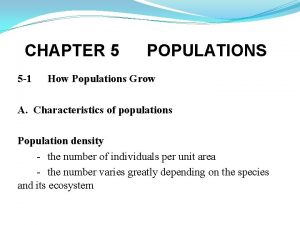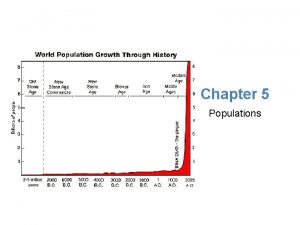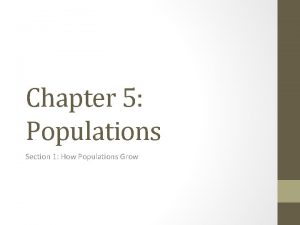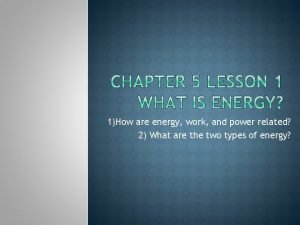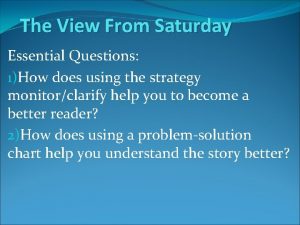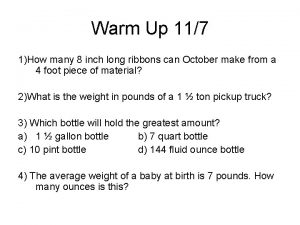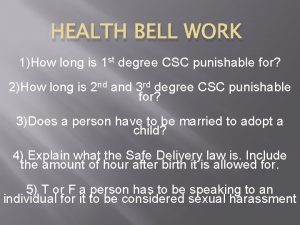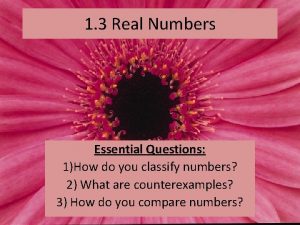Populations Chapter 14 Part 1How Populations Grow Populations

























- Slides: 25

Populations Chapter 14

Part 1—How Populations Grow

Populations • A _______ is a group of organisms of a single species that live in a given area. • A _______ is a group of organisms that reproduce fertile offspring. 3

Characteristics of Populations 1) __________ __ distribution—the area inhabited by the population 2) __________ __—number of individuals per unit area —Example: 100 people per square mile 3) __________ __—the change in population over time

Population Growth • There are three things that determine population size: – Number of __________ – Number of individuals that ______ or ______ a population • In general, a population will grow when the

Exponential Growth • __________ __ occurs when individuals in a population reproduce at a constant rate. – At first, the population increases slowly, but over time it can reach almost infinite size. • Under _____ conditions with unlimited resources a population Exponential Growth J-SHAPED CURVE

Growth With Limits • As resources become less available, the growth of a population slows or stops. • The number of individuals an environment can support is called its __________ __. • What happens when a population gets larger Logistic Growth S-SHAPED CURVE

Zero Population Growth • What happens to population size if birth rate and death rate are the same? • ___________ __ is what happens when birth and death rates are the same 8

Part 2—Relationships

Competition • _________ occurs when organisms of the same or different species attempt to use a resource in the same place or at the same time. – A ________ is anything necessary for life, like water or food. • The ________________________ __ states that no two species can occupy the same niche in the same habitat at the same time

Predation • ________ is when one organism captures and feeds on another organism – The organism that kills and eats is called the predator – The organism that gets eaten is called the prey

Symbiosis • Any relationship in which two species live closely together is called __________ _. • There are three main classes of symbiosis: – Mutualism – Commensalism – Parasitism

Mutualism • In _________, both species benefit from the relationship. – For example, flowers provide hummingbirds with food in the form of nectar, while the birds pollinate the flowers and help them reproduce.

Commensalism • In __________, one species benefits while the other is neither helped nor harmed. – For example, small marine animals called barnacles attach themselves to whales. The whales receive no benefit or harm, but the barnacles benefit from the movement of the whale, which gives them access to food.

Parasitism • In __________, one organism lives on or inside another organism and harms it. • The parasite gets its nutritional needs from the host. – For example, a flea lives of the blood of mammals.

Limiting Factors • A ___________ is something that causes population growth to decrease. • A limiting factor can be ____________ __, only affecting the population when it reaches a certain size and density, or _________, affecting the entire population

Density Dependent Factors: Competition • Since resources in a given area are limited, when population increases, organisms ____ with one another food, space, and other life essentials. • Competition can happen between members of the same species, or between members of species who are competing for the same

Density Dependent Factors: Predation • Population can be controlled by predation, which happens through a ______________________ __: • 1) Prey population grows • 2) Predator population grows • 3) Prey population shrinks • 4) Predator population shrinks

Density Dependent Factors: Parasitism and Disease • Like predators, parasites live at the expense of their ____. • Parasites and disease can affect populations more severely based on the density of the population. • Over time, parasites can weaken and kill their host

Density-Dependent Factors: Crowding and Stress • Most animals have a built-in need for a certain amount of space. – Space can be used for nesting, hunting, etc. • When organisms become over-________, they might fight, increasing levels of stress. This can cause hormonal changes that can weaken or kill animals. 20

Density Independent Factors • Regardless of population size, events like: – Unusual ______ – Natural ______ – _________ __ like clearing forests will affect population size.

Human Population Growth • Like the populations of other organisms, human population tends to increase over time. • For most of human history, there were many limiting factors – food, disease, sanitation • In recent history, industrial advances removed some limiting factors, resulting in ___________

Patterns of Population Growth • The scientific study of human populations is called ___________. • __________ examine the characteristics of human populations and attempt to explain how those populations will change over time. • Birth rates, death rates, and age structure help predict why some countries have a high growth rate while others grow 23

Demographic Transition • ____________ _ refers to a dramatic change in birth and death rates. • Throughout history, societies had high birth rates and high death rates • With modernization, the death rate falls, while the birth rate remains high. • With more modernization, families have fewer children, and population growth slows. 24

Age Structure • Population growth depends in part on how many people of different ages make up a given population • Demographers can predict future growth using ____________________, which graph 25 the numbers of people in different age groups of the population.
 5-1 how populations grow
5-1 how populations grow Chapter 5 lesson 1 how populations grow
Chapter 5 lesson 1 how populations grow Section 5-1 how populations grow
Section 5-1 how populations grow Population growth concept map answers
Population growth concept map answers Section 5-1 how populations grow
Section 5-1 how populations grow 5-1 how populations grow
5-1 how populations grow Think and grow rich chapter 10
Think and grow rich chapter 10 Chapter 16 evolution of populations vocabulary review
Chapter 16 evolution of populations vocabulary review Chapter 13 how populations evolve test
Chapter 13 how populations evolve test Chapter 17 evolution of populations answer key
Chapter 17 evolution of populations answer key Chapter 23: the evolution of populations
Chapter 23: the evolution of populations Section 16-1 genes and variation
Section 16-1 genes and variation Chapter 10 comparing two populations or groups crossword
Chapter 10 comparing two populations or groups crossword Chapter 8 understanding populations
Chapter 8 understanding populations Chapter 23 the evolution of populations
Chapter 23 the evolution of populations Chapter 21 vulnerability and vulnerable populations
Chapter 21 vulnerability and vulnerable populations Chapter 13 how populations evolve
Chapter 13 how populations evolve Chapter 10 comparing two populations or groups
Chapter 10 comparing two populations or groups Part part whole addition
Part part whole addition Unit ratio definition
Unit ratio definition Part part whole
Part part whole Technical descriptions
Technical descriptions Front bar layout
Front bar layout The part of a shadow surrounding the darkest part
The part of a shadow surrounding the darkest part Minitab adalah
Minitab adalah Icivics we're free let's grow answer key
Icivics we're free let's grow answer key
